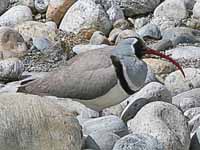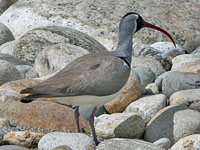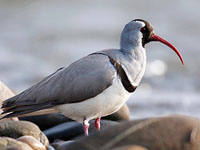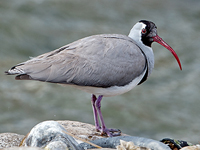SHOREBIRDS
Most Shorebirds walk along shores probing for food with their thin sensitive bills. Bill length varies considerably so differing species can work the same shore and obtain different
food supplies. Shorebirds include sandpipers, godwits, stilts, oystercatchers, plovers, and many more. Shorebirds belong to the Charadriiformes order which also includes the Gulls
and Allies.
Note: the term Shorebirds is used in the Americas; elsewhere "waders" is used. We will reserve "waders" for herons and allies.
Some Charadriiformes families:
Burhinidae: thick-knees; Charadriidae: small plovers, lapwings; Glareolidae: courses, pratincoles; Haematopodidae: oystercatchers
Jacanidae: jacanas; Recurvirostridae: avocets, stilts; Scolopacidae: small bill sandpipers, large bill sandpipers.
Note: the term Shorebirds is used in the Americas; elsewhere "waders" is used. We will reserve "waders" for herons and allies.
Some Charadriiformes families:
Burhinidae: thick-knees; Charadriidae: small plovers, lapwings; Glareolidae: courses, pratincoles; Haematopodidae: oystercatchers
Jacanidae: jacanas; Recurvirostridae: avocets, stilts; Scolopacidae: small bill sandpipers, large bill sandpipers.
Oystercatchers
Order Charadriiformes Family Haematopodidae - 1 genus
Oystercatchers are the only types of bird in family Haematopodidae. They have two different type of plumage: pied or black. The pied oystercatcher has mostly black plumage including the head, neck, and tail. The black type has all black plumage. The variable oystercatcher is an except; some subspecies are all black, but others have some white on the underparts, but none as much white as the pied oystercatchers.
All oystercatcher have a brightly colored long and straight bill which is red, orange, or something in between. The tip of the bill may be blunt or pointed, that shape being mainly determined by how it is used. If the bill is used to hammer and pry at shells, it will become rounded with wear. If it is used to do soft jobs such as dig for worms, it will be sharper. Oystercatchers all have eye-rings, and they, along with the eyes are brightly colored too: red, orange, or yellow. The legs vary from white to red.
Oysters are not high up on the list of an oystercatcher's food list. But they do have the unique ability to be able to open and oyster shell, and that merits their name. Mollusks in general are a favorite food for most oystercatchers, and they too require opening. Limpets are a similar food, but instead of being bi-valved, they only have one shell. They are really a type of snail. Other foods are sea urchins, starfish, crabs, and worms. The worms are not just aquatic worms, but some oystercatchers during breeding season will frequent pastures and seek earthworms and insect larvae.
The nest a scrape in the sand or ground. They may be a little vegeation placed in the nest, or even small pebbles. The eggs are patterned with specks for camaflauged. They are incubated by both parents for about 32 days.
Genus Haematopus
New World Oystercatchers
Oystercatcher,_African (Black) Haematopus moquini Found: Africa
Description: The African oystercatcher, also known as the African black oystercatcher, has black plumage. It has a long orange-red to red bill, red eyes, a red eye-ring; and pinkish-red legs. The female at up to 45 cm long is larger and has a slightly longer bill than the male.
Range: Southern Africa.
Habitat: Rocky shores and offshore islands.
Diet: Mollusks, limpets (a shell-like snail), bristle worms; also insect. Uses its bill to pry open mollusks.
Conservation status: It is listed as Least Concern even though they may be only 6000 adults.
Image by: 1) Dick Daniels - De Hoop, South Africa 2) Sandy Cole - De Hoop 3) Dick - Plettenberg Bay 4) Cristiano Crolle - PaternosterRange: Southern Africa.
Habitat: Rocky shores and offshore islands.
Diet: Mollusks, limpets (a shell-like snail), bristle worms; also insect. Uses its bill to pry open mollusks.
Conservation status: It is listed as Least Concern even though they may be only 6000 adults.

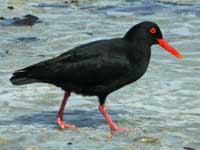
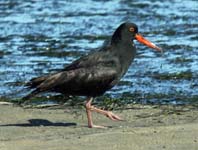
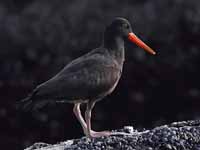
Oystercatcher,_American Haematopus palliatus
Description: The American oystercatcher has pied plumage. It has an orange-red bill, yellow eyes, an orange eye-ring, and pink legs. The eggs are grey and speckled with dark brown, They are incubated by both parents for about 25 days. The American oystercatcher is up to 44 cm long. There may be a range overlap in southern South America with the similar Magellanic oystercatcher. It is is darker and has no white on the shoulder.
Range: The Americas.
Habitat: Coasts with clean water.
Diet: Oysters, clams. limpets (a shell-like snail), sea urchins, starfish, crabs, and worms
Conservation status: Least Concern.
Image by: 1, 2, 3) Dick Daniels - North Carolina 3) Nick Athanas - Chile Range: The Americas.
Habitat: Coasts with clean water.
Diet: Oysters, clams. limpets (a shell-like snail), sea urchins, starfish, crabs, and worms
Conservation status: Least Concern.

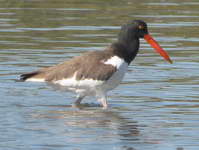
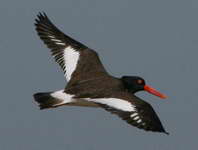
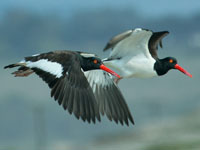
Oystercatcher,_Black Haematopus bachmani
Description: The Black oystercatcher has black plumage. It has a 9 cmlong red bill, yellow eyes, a red eye-ring, and pink legs. The Black oystercatcher is up to 45 cm long.
Range: West coast of North America.
Habitat: Shorelines, favoring rocky areas.
Diet: Mollusks, limpets, small crustaceans.
Conservation status: It is listed with a status of Least Concern, but there are only about 10,000.
Image by: 1, 2, 3) Dick Daniels - California 4) Becky_Matsubara - CARange: West coast of North America.
Habitat: Shorelines, favoring rocky areas.
Diet: Mollusks, limpets, small crustaceans.
Conservation status: It is listed with a status of Least Concern, but there are only about 10,000.
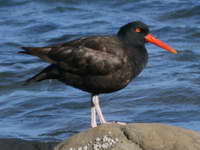
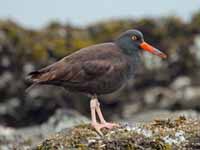


Oystercatcher,_Blackish Haematopus ater Found: South America
Description: The blackish oystercatcher has a black wings and a dark brown back. It has a red bill, eyes, and eye-ring. The legs are white legs. The blackish oystercatcher is 43 to 45 cm long.
Range: West coast of South America; Atlantic coast from Argentina and south.
Habitat: Rocky coastal shores.
Diet: Mussels, limpets, crustaceans.
Conservation status: Least Concern.
Image by: 1, 2, 3) Nick Athanas - Peru, Peru, Falkland Islands 4) Under_the_same_Moon - ArgentinaRange: West coast of South America; Atlantic coast from Argentina and south.
Habitat: Rocky coastal shores.
Diet: Mussels, limpets, crustaceans.
Conservation status: Least Concern.
1) Juvenile and adult
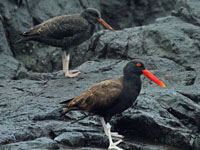
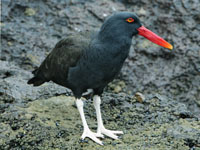
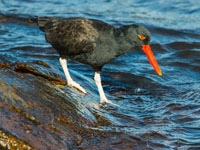

Oystercatcher,_Magellanic Haematopus leucopodus
Description: The Magellanic oystercatcher has pied plumage. It has an orange bill, yellow eyes, yellow eye-ring;, and whitish legs. The Magellanic oystercatcher is up to 46 cm long. The similar American oystercatcher has more white on the shoulder.
Range: Argentina, Chile, Falkland Islands.
Habitat: It breeds on inland grasslands, spends rest of year at the coast.
Diet: Earthworms and insect larvae during breeding season; mussels; at other times - limpets, aquatic worms.
Conservation status: Least Concern.
Image by: 1, 4) Nick Athanas - Chile, Argentina 2) D Faulder - the Falkland Islands 3) Brian Ralphs - Patagonia Range: Argentina, Chile, Falkland Islands.
Habitat: It breeds on inland grasslands, spends rest of year at the coast.
Diet: Earthworms and insect larvae during breeding season; mussels; at other times - limpets, aquatic worms.
Conservation status: Least Concern.
4) Oystercatcher and Hudsonian Godwit


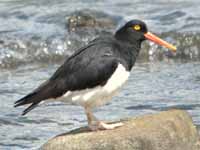

Eurasian Oystercatchers
Oystercatcher,_Eurasian Haematopus ostralegus
Description: The Eurasian oystercatcher, also known as oystercatcher, has pied colored plumage. It has a red bill, eyes, and eye-ring. The legs are pink. The Eurasian oystercatcher is up to 45 cm long. When flying, much more white is visible on the Eurasian oystercatcher's back than on the Americian oystercatcher's back. Their ranges do not overlap.
Range: Europe, Asia, Africa. It is the most widespread of the oystercatcher species.
Habitat: Some breed inland, but all are coastal during the winter.
Diet: Mollusks, limpets, whelks, crabs, worms.
Conservation status: It is listed as Near Threatened because of fears that the commercial harvesting of mollusks will effect the oystercatcher's food supply. That said, the population is currently well over 100,000 and does not seem to be declining.,
Image by: 1) Dick Daniels - Scotland 2) Smudge_9000 3) Andreas_Trepte 4) Cristiano Crolle - Texel, Holland Range: Europe, Asia, Africa. It is the most widespread of the oystercatcher species.
Habitat: Some breed inland, but all are coastal during the winter.
Diet: Mollusks, limpets, whelks, crabs, worms.
Conservation status: It is listed as Near Threatened because of fears that the commercial harvesting of mollusks will effect the oystercatcher's food supply. That said, the population is currently well over 100,000 and does not seem to be declining.,
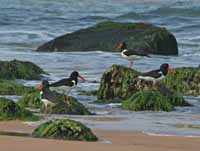
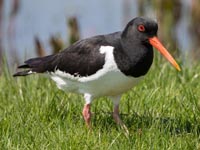
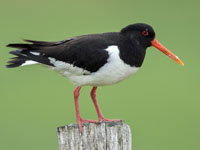
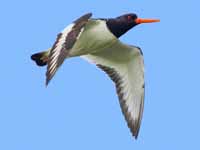
Australian Oystercatchers
Oystercatcher,_Pied Haematopus longirostris
Description: The pied oystercatcher has pied coloring. It has an orange-red bill and eye-ring. The eyes are red as are the legs. The pied oystercatcher is up to 51 cm long, which makes it one of the largest oystercatchers.
Range: Australia.
Habitat: During breeding season, slightly inland at salt marshes or pastures; also sand dunes. At other times, sandy beaches and mud flats.
Diet: Mainly mollusks, worms; other invertebrates.
Conservation status: Least Concern.
Image by: 1, 3) Laurie_Boyle 2) Dick Daniels - Australia 4) JJ_Harrison
- Tasmania, Australia Range: Australia.
Habitat: During breeding season, slightly inland at salt marshes or pastures; also sand dunes. At other times, sandy beaches and mud flats.
Diet: Mainly mollusks, worms; other invertebrates.
Conservation status: Least Concern.

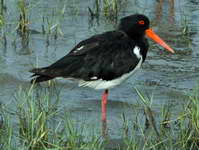
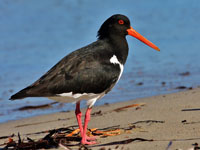
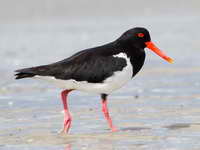
Oystercatcher,_Sooty Haematopus fuliginosus
Description: The sooty oystercatcher has all black plumage. The bill, eyes, and eye-rings are orange-red. It has pink legs. The sooty oystercatcher has a longer tail than other species, which resutls in it being the longerst of the species, up to 52 cm long.
Range: Australia.
Habitat: Rocky shores; also sandy shores.
Diet: Mollusks, limpets, crustaceans, aquatic worms.
Conservation status: Least Concern.
Image by: 1) JJ Harrison - Tasmania 2) Glen
Fergus on Ladt Elliot Island, Australia 3) Charlie Westerinen - Wollongong, Australia 4) Andrej_Chudy - New Zealand Range: Australia.
Habitat: Rocky shores; also sandy shores.
Diet: Mollusks, limpets, crustaceans, aquatic worms.
Conservation status: Least Concern.
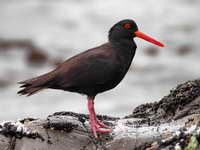
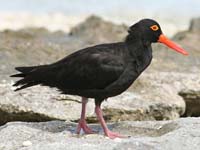
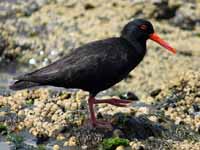
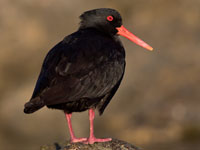
New Zealand Oystercatchers
Oystercatcher,_Chatham Haematopus chathamensis
Description: The Chatham oystercatcher has black upperparts, head, neck, and upper-breast. The rest of the underparts are white. The bill is reddish-orange. It has yellow eyes with orange eye-rings and the legs are pink.
The Chatham oystercatcher is about 48 cm long.
Range: Chatham Islands of New Zealand.
Habitat: Rocky shores; also sandy beaches; infrequently pastures.
Diet: Mollusks, snails, limpets, marine worms.
Conservation status: It is listed as Endangered because there are less than 500. Threats are cats and cattle that walk the beaches and trample eggs.
The Chatham oystercatcher is about 48 cm long.
Range: Chatham Islands of New Zealand.
Habitat: Rocky shores; also sandy beaches; infrequently pastures.
Diet: Mollusks, snails, limpets, marine worms.
Conservation status: It is listed as Endangered because there are less than 500. Threats are cats and cattle that walk the beaches and trample eggs.
Image by: 1) Peter Crosson 2) Jeff_Flavell 3) Dept_Conservation
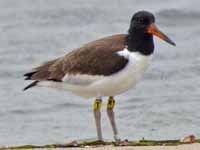
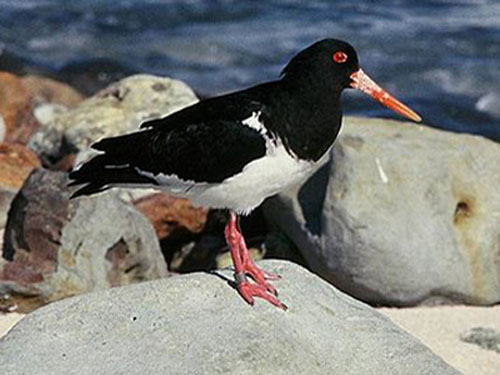

Oystercatcher,_South Island Haematopus finschi
Description: The South Island oystercatcher, also known as the South Island pied oystercatcher, has pied plumage. It has an orange to red bill, red eyes, and thin red eye-rings. The legs are pink. None of the subspecies of the variable oystercatcher has as much white on its underparts.
Range: Breeds on the South Island of New Zealand, winters on the North Island.
Habitat: The breeding bird is mainly found inland. On the North Island it is found in estuaries and harbors.
Diet: Mainly mollusks and worms.
Conservation status: Least Concern.
Image by: 1) Paul Davey - New Zealand 2) Sid_Mosdell 3, 4) Seabird NZ Range: Breeds on the South Island of New Zealand, winters on the North Island.
Habitat: The breeding bird is mainly found inland. On the North Island it is found in estuaries and harbors.
Diet: Mainly mollusks and worms.
Conservation status: Least Concern.
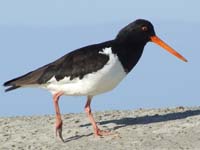
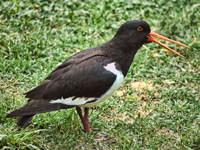
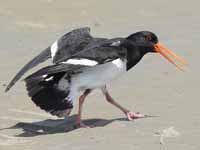

Oystercatcher,_Variable Haematopus unicolor
Description: The variable oystercatcher has black upperparts. The underparts are variable from all black to black-and-white. It has a red bill, eye, and eye-ring. The variable oystercatcher is up to 50 cm long. The similar South Island oystercatcher has well defined boundaries between black and white while the variable has blurry boundaries between any black and white areas.
Range: New Zealand.
Habitat: Prefer sandy shores; also frequent rock shores. Pastures are visited, especially after rains, for worms.
Diet: Mollusks, crustaceans, worms, small invertebrates and sometimes small fish.
Conservation status: Least Concern.
Image by: 1, 3, 4) Dick Daniels - New Zealand 2) Bernard_SpraggRange: New Zealand.
Habitat: Prefer sandy shores; also frequent rock shores. Pastures are visited, especially after rains, for worms.
Diet: Mollusks, crustaceans, worms, small invertebrates and sometimes small fish.
Conservation status: Least Concern.
1, 2) Black variant 3, 4) Mottled variant
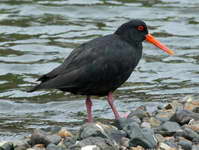


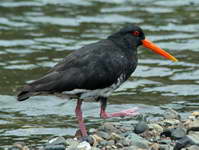
This family has only one genus, and that has only one species.
Genus Ibidorhyncha - 1 species
Ibisbill Ibidorhyncha struthersii Found: central Asia
The Ibisbill has grey upperparts; white underparts; long down-curved bill; black face, breast-band; white belly; red legs.
Image by: 1, 2) Ron Knight 3) Vishal Sabharwal - India 4) Koshy_Koshy